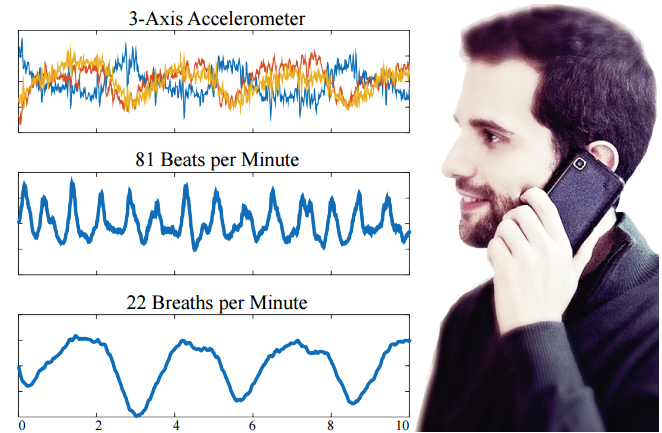November 15, 2015 weblog
Heart rate tracking with the use of smartphone in pocket

An MIT group project called BioPhone is doing research that involves biological signals from a smartphone's accelerometer. In their approach, motion sensors would recover heart and breathing rates of the users during stationary positions and activities such as listening on the phone.
The research team, from the Media Lab at MIT, are the authors of "BioPhone: Physiology Monitoring from Peripheral Smartphone Motions." They are Javier Hernandez, Daniel J. McDuff and Rosalind W. Picard. They have in mind the heart rate (HR) and breathing rate (BR) for capture from motion data.
Rachel Metz in MIT Technology Review said their work builds on ongoing efforts by Hernandez and colleagues "to use mobile devices—and wearables, in particular—for measuring heart and breathing rates in less obtrusive ways in hopes of tracking your stress level."
The authors said that "While great strides have been made to provide comfortable physiological monitoring, traditional methods still require attaching electrodes to the skin and/or interrupt daily activities."
They are looking for less cumbersome ways. They wrote, "motion sensors embedded in head-mounted and wrist-worn wearable devices such as Google Glass and Galaxy Gear can capture heart and breathing rates accurately. While the results were very promising, not everybody uses these types of wearable devices as they may be cumbersome and stigmatizing."
Enter the smartphone, this time taking on the role of monitoring via sensors while being carried in different locations on the body. The phone may be in the user's pocket or bag and used during other phone activities such as watching a video, or listening to a conversation.
The goal has been to develop an automated method for recovering the pulse and respiratory waveforms from which heart and breathing rates can be extracted. For their research they used the 3-axis accelerometer of a Samsung Galaxy S4 to capture physiological parameters from a person carrying the phone. They wrote Android software that captured data at an average sampling rate of 100 Hz.
They evaluated the accuracy of their methods against FDA-cleared devices that monitored electrocardiography (ECG) and respiration.
They recruited 12 participants, with each asked to hold three different body postures, standing, sitting and lying down before and after pedaling on a static bike. This enabled capture of a range of physiological parameters as well as studying the impact of postures that have been shown to mediate BCG signals.
The authors said that "while the results are very promising there are still several research challenges that need to be addressed in order to provide continuous physiological measurement."
(According to Metz, Hernandez said there were "still challenges to overcome." He said that "researchers still have to figure out how to measure heart and breathing rates reliably when the smartphone is in different spots.")
Said the authors in their paper: "As these methods continue to advance, we hope they will be used to create passive and comfortable assessments that foster greater health and wellbeing during daily life."
More information: BioPhone: Physiology Monitoring from Peripheral Smartphone Motions, PDF: web.media.mit.edu/~javierhr/fi … nandez-etal-EMBC.pdf
© 2015 Tech Xplore



















